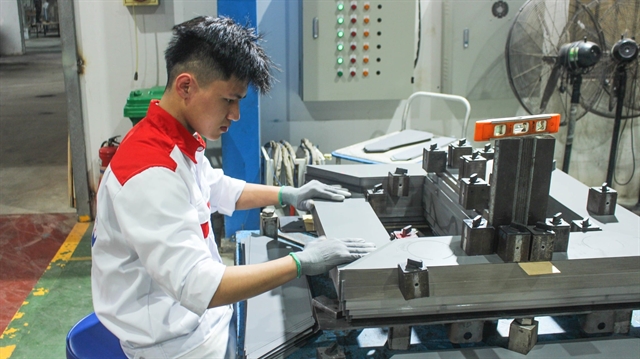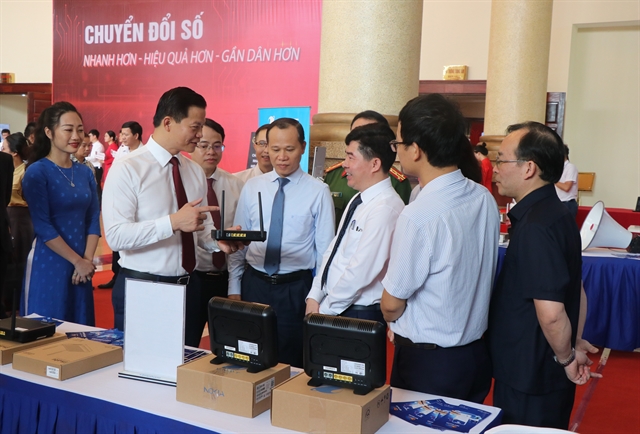 Economy
Economy


|
| A corner of the Tiên Sa Port. Experts says Tiên Sa Port should not be enlarged because a bypass system linking the port and the logistics centre would damage Đà Nẵng City's architecture planning. - VNS Photos |
ĐÀ NẴNG — Speeding up the construction of the new Liên Chiểu Cargo Port would help promote Đà Nẵng as a key international logistics centre, and allow the existing Tiên Sa Port to be reserved for cruise ships only.
Former general director of Tiên Sa Port, Nguyễn Hữu Sia, made the statement at a recent workshop held to discuss changes to the city's Master Plan proposed by Sakae Holdings and Subarna Jurong Consultants from Singapore.
Sia said the proposal to build Liên Chiểu Port and a logistics centre was planned with support from the Japanese International Co-operation Agency (JICA) in 2005, and construction for the first stage was scheduled for 2025.
He said Tiên Sa Port, which was built in 1965, could only handle 12 million tonnes of cargo per year, and any expansion to it would trigger more serious traffic congestion and accidents on the main road linking the port as well as hit tourism in Sơn Trà and Ngũ Hành Sơn districts.
He said Liên Chiểu Port would be more convenient as it would connect National Highway 1A, Đà Nẵng-Quảng Ngãi Expressway, Industrial Zones and Hi-tech Parks and Đà Nẵng International Airport.
Liên Chiểu would provide a cargo link with Chân Mây Port in Thừa Thiên-Huế, 40km away, and Chu Lai Port and airport 70km from the Đà Nẵng-Quảng Ngãi Expressway and Dung Quất in Quảng Ngãi, he added.
No new port
The latest proposals from the Singaporean firms involve expanding Tiên Sa Port for both cargo ships and cruise liners, with no new Liên Chiểu Port included.
Vũ Thị Tuấn Anh from Sakae Holdings said the development of Liên Chiểu Port would pollute Đà Nẵng Bay – an ideal site for luxury tourism development.
“We've said Đà Nẵng should not build Liên Chiểu Port in our proposal. Luxury tourism services including healthcare tours, smart tourism and vacations will create major revenue for the city’s coffers,” Anh said.
She said the plan would help Đà Nẵng become a global financial centre and hi-end tourism hub, while the city’s logistics services could be linked to the ports of Chân Mây, Dung Quất and Chu Lai.
‘Green’ Tiên Sa Port
Nguyễn Tấn Đạt, a shipping company representative, disagreed with the plan, saying the expansion of Tiên Sa Port to 28 million tonnes of cargo per year would take up docks reserved for the Navy, petrol storage facilities, the fisheries industry and Sơn Trà Nature Reserve.
Commenting on the proposals, Olivier Soquet from De-So urban design firm, said Đà Nẵng should share links with the neighbouring airports of Phú Bài in Huế City and Chu Lai in Quảng Nam by rail and expressways instead of expanding the port.
He said Tiên Sa Port should not be enlarged because a bypass system linking the port and the logistics centre would damage the city’s architecture.
He also disagreed with a development plan in the mountainous area to the west of the city, while saying farming areas in the inner city must be reserved for urban farming development.
Eco-urban
Mayso Prasha from creative firm Callison RTKM said the Master Plan would take up alleys which were home to millions of family businesses and traditional markets.
He said Đà Nẵng has a unique landscape ranging from the sea, rivers, the delta and mountains, but a tourist attraction on the river had yet to be proposed.
Mayso agreed with the Singaporean consultants on urban development outside the current city centre, but warned that sky-rises should not be built in the new urban and more ‘green’ spaces were needed.
He suggested an eco-district reserved for pedestrians and non-engine vehicles could be built in Đà Nẵng, maybe on the Sơn Trà Peninsula.
Matsumura Shigeru from Nikkei Sekkei said sustainable and ecological development must be the top priority in the urban expansion plan, and it should include a ‘green’ living area and a 50 per cent reduction of motorbikes and 35 per cent increase in public buses.
Vice-chairman of the central city’s People’s Committee Đặng Việt Dũng asked the consultancy companies from Singapore to adjust the 2030-45 Master Plan before submitting it to the Prime Minister for approval.
Dũng said Đà Nẵng had been designed for future sustainable development on the basis of key elements – tourism, hi-tech industries, logistics and marine economy – with an average growth of 10.1 per cent and per capita income of US$8,700 by 2045.
“We plan a smart city with a population of 2.5 million in 2045. Tourism and services and hi-tech agriculture will be included in the Master Plan, as well as underground transport solutions with seaports and logistics services,” he said.
Liên Chiểu Port would handle cargo ships and a main logistics centre for the north-south railway and road network, connecting the East-West Economic Corridor No 2 with Thailand, Myanmar and Laos, he added. — VNS